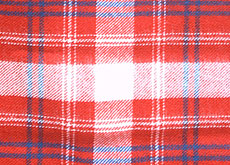Scots give green light to Swiss red tartan

The kilt - normally the preserve of Scotsmen - can now be worn by the Swiss, who have recently acquired their own tartan.
Scottish clan council approval of a “Swiss Red” plaid puts the Maurers, Masonis and Morels on equal sartorial footing with the MacDonalds, MacLeods and Montgomerys.
The opening of the first Swiss general consulate on Scottish soil last month was seen as reason enough to give the go-ahead to the Swiss red and white checked tartan.
While the pattern is traditional, its colour combination is not.
The red and white stripes stand for the Swiss national colours, while the blue checks represent the Scottish flag, the white cross of St Andrew against a blue background.
The light-blue double-check stripes symbolise the new Swiss solidarity with Scotland’s five million inhabitants, plus the more than 20 million people of Scottish descent worldwide.
Not Scot free
The new Swiss tartan seems to have made a favourable first impression on the citizens of the Scottish capital.
As Swiss consul general Bruno Widrig donned his kilt for the media at the foot of Edinburgh Castle, passers-by stopped to ask the meaning of the new tartan, and where it could be bought.
Unfortunately, dressing to the nines Scottish style does not come cheap.
A normal kilt costs SFr670-900 ($540-725), while those coveting a top-of-the-line Harris tweed model need to shell out as much as SFr1,300.
Additional accoutrements, including the sporran – a leather purse worn on the front of the kilt – the sgian dubh, a sock knife, not to mention headgear, jackets, shirts, shoes and knee socks further ratchet up the cost.
Full highland dress will set the kilt lover back about SFr6,700.
Given that different kilts are required for different occasions, digging so deeply into their pockets must take a toll on the legendarily thrifty Scots.
The pain for Swiss or Scots invited to royal celebrations is even greater: the cost of full highland dress for formal occasions runs to SFr10,000 or more.
As for what Swiss kilt-wearers will wear under their kilts, the answer is the same as if they were in Scotland.
Only in Edinburgh
At the moment, “Swiss Red” exists only in a sample version woven at the Edinburgh Old Town Weaving Company, located on The Royal Mile between Holyrood Palace and Edinburgh Castle.
The company is excitedly awaiting the global response to its Swiss tartan.
If enough orders are placed, metres or even kilometres of the red, white and blue tartan will be spun on the Royal Mile.
But for the time being, the only people sporting the Swiss tartan are the Swiss consul general in Edinburgh and his wife.
Scotland has enjoyed considerable autonomy while remaining a part of Britain since July 1998.
The Scottish Parliament, opened in Edinburgh in 1998, has the right to decide upon questions related to sports, rights, culture, and representation abroad.
In Edinburgh there are more than 40 permanent diplomatic missions. Switzerland has had its own representation there since May 2006.
Kilt production is important to Scotland’s economy.
Scots consider it normal to wear kilts with accoutrements on special occasions.
Scottish football fans represent their country in kilts as a matter of course.
Scottish clans all have their own tartans.
(Adapted from German by Kathleen Peters)

In compliance with the JTI standards
More: SWI swissinfo.ch certified by the Journalism Trust Initiative
You can find an overview of ongoing debates with our journalists here. Please join us!
If you want to start a conversation about a topic raised in this article or want to report factual errors, email us at english@swissinfo.ch.